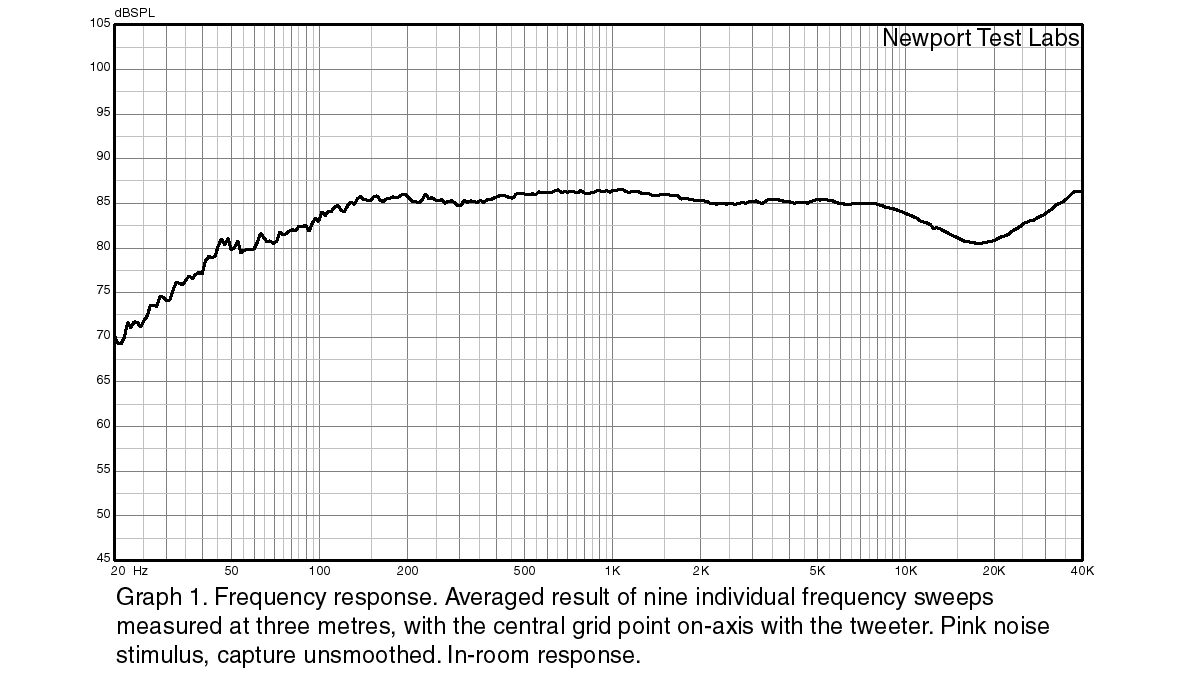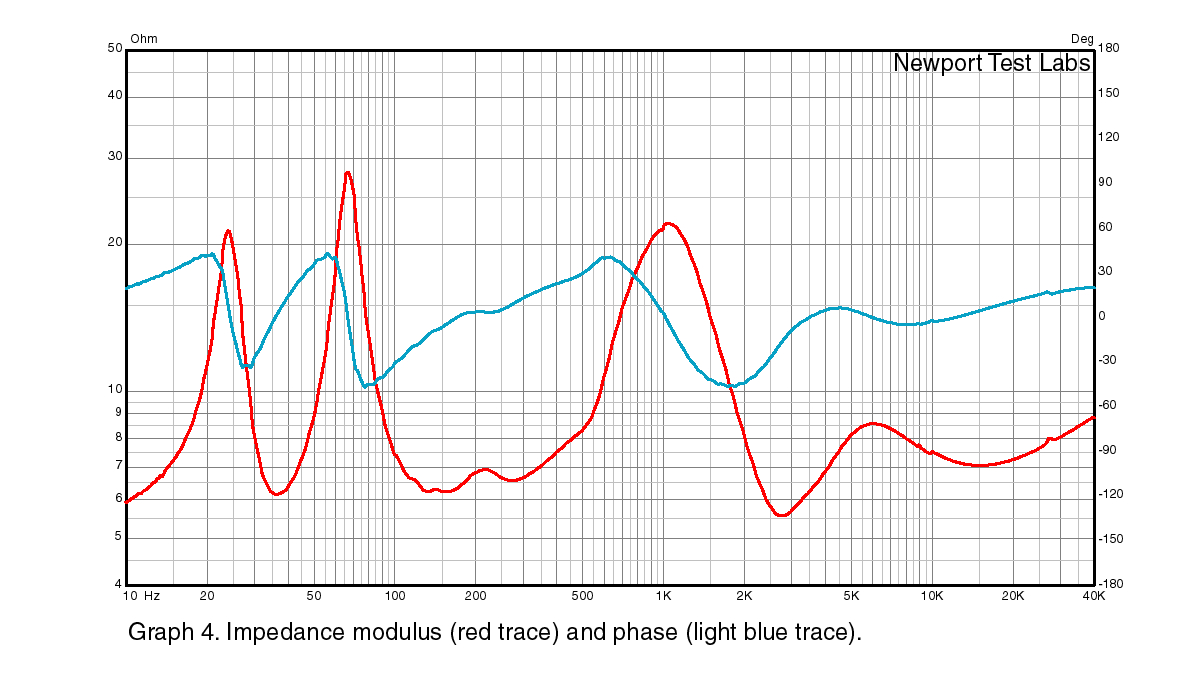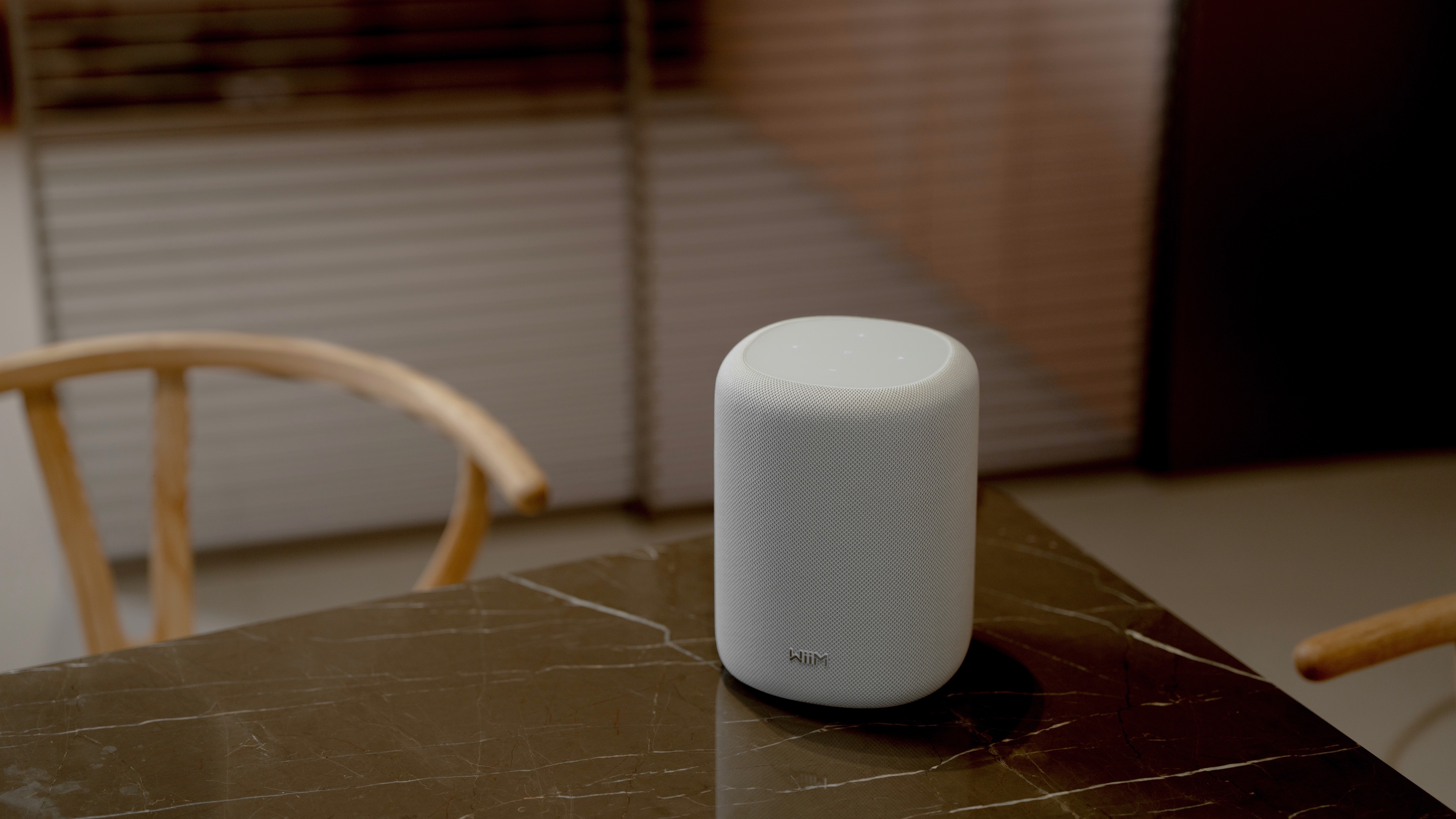What Hi-Fi? Verdict
With miraculous midrange, deceptively strong bass for the speaker's size, and clear treble, these magical speakers from Harbeth make you feel as if you're listening to the real thing.
Pros
- +
Sounds like live
- +
Midrange accuracy
- +
Ultra-clean bass
Cons
- -
Two finishes only
- -
No bi-wiring
- -
Custom stands required
Why you can trust What Hi-Fi?
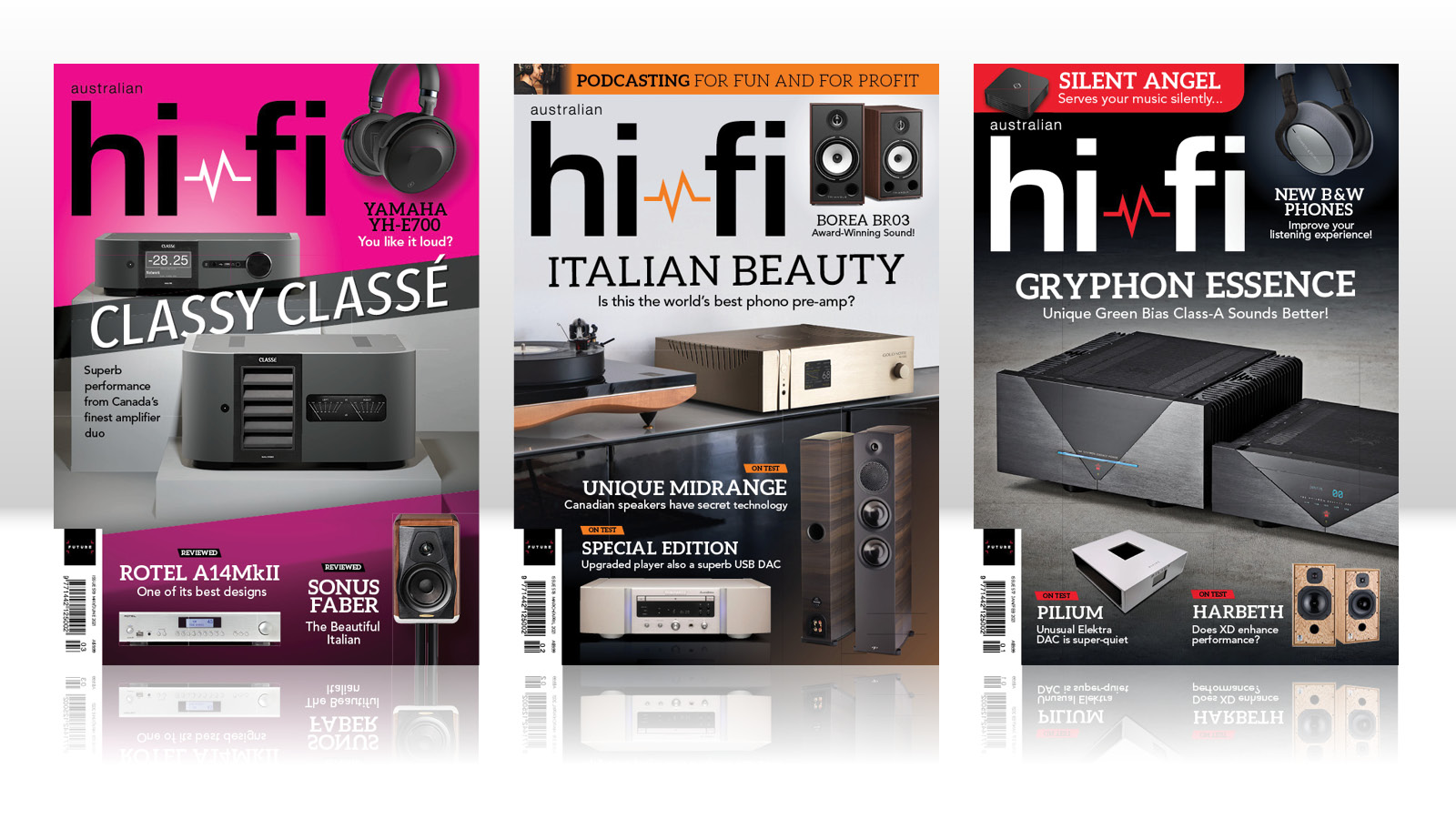
This review and test originally appeared in Australian Hi-Fi magazine, one of What Hi-Fi?’s sister titles from Down Under. Click here for more information about Australian Hi-Fi, including links to buy individual digital editions and details on how to subscribe.
Harbeth tricks me every time. Every time the courier delivers a pair of Harbeth loudspeakers for review, I prepare to lift the first carton by bending my knees and keeping a straight back, then when I lift, I end up virtually launching the carton towards the ceiling, so light-weight is the speaker inside it.
If you are familiar with Harbeth, its illustrious history, and its BBC heritage, you’ll already know that the speakers are designed to have as little mass as possible, because it is precisely this lack of mass that contributes to their unique sound.
But if you are more used to speakers that weigh as much as the average person, the weight of the Compact 7ES-3 XDs will come as a total surprise. I will discuss the reason for this later in this review. The question you should be asking yourself right now is why I am reviewing a pair of Harbeth loudspeakers at all.

The answer is that Harbeth’s owner and head designer, Alan Shaw (pictured), has bought himself some new test equipment and its increased resolution has enabled him to pinpoint a few small issues that had bothered him in the past, with the happy result that he has been able to make some incremental improvements to every one of the speakers in the range, so they’ve been re-named ‘XD’ (eXtended Definition).
Shaw says: “My test and measurement facilities give me a sonic ‘microscope’ into the performance of the speaker. Over the years I have invested in a more and more powerful analytical ‘microscope’, and small deviations from perfection that I could not observe years ago are now very obvious.
"So I have flattened-out small ‘lumps and bumps’ in the frequency response by using custom made resistors, coils and capacitors. So the overall sound is better integrated bass/mid/top.”
These ‘XD’ series speakers (P3ESR XD, C7ES-3 XD, Monitor 30.2 XD, Super HL5plus XD and Monitor 40.2 XD) supersede the previous 40th Anniversary series but, as you can see from the model numbers, are essentially the same speakers in that all the drive units and the cabinets are identical.
The latest hi-fi, home cinema and tech news, reviews, buying advice and deals, direct to your inbox.
Although there are electronic differences between the older models and the XD models, which I will discuss a bit further on in this review, there has been a massive change in cosmetics because unlike the Anniversary models, which didn’t offer a choice of cabinet finishes, the new XD Series models are available in a wide range of finishes, although rather strangely, not all the same finishes are available for every model.
Equipment
Some of those incremental electronic improvements have come about by using new binding posts, British-made audio-grade poly capacitors, and an XD version of Harbeth’s ultra-pure OFC cable for all internal links.
The new terminals on the rear panel connect directly to the printed circuit board that contains the crossover components, which shortens the signal path and minimises transition losses. As for the crossover network itself, in addition to the new capacitors, other parts on it have been subtly modified, as per Shaw’s explanation in the introduction.
The 200mm diameter bass/midrange driver in the 7ES-3 XD is injection-moulded and uses the second generation of a special formulation of polypropylene that Harbeth developed in partnership with the University of Sussex, using grant money from the British Government Science & Engineering Research Council.
The first generation of this material was dubbed ‘RADIAL’, which was an acronym invented by Shaw to stand for ‘Research And Development In Advanced Loudspeakers’, and in fact the very first speaker in which it was used was an early ancestor of the 7ES-3 XD, the C7. RADIAL2 is an evolution of that original formulation.
Designing and building a custom bass/midrange driver is a very expensive process so it’s little wonder that Harbeth uses the exact same driver that’s used in the 7ES-3 XD in other of its models, such as the Super HL5plus and M30.1. Although Harbeth rates this cone as being 200mm in diameter, its Thiele/Small diameter (which – along with other important driver parameters – is what’s used by designers to determine the correct volume for the cabinet and the dimensions of the bass reflex port) is just 165mm, which results in an effective cone area (Sd) of 214cm².
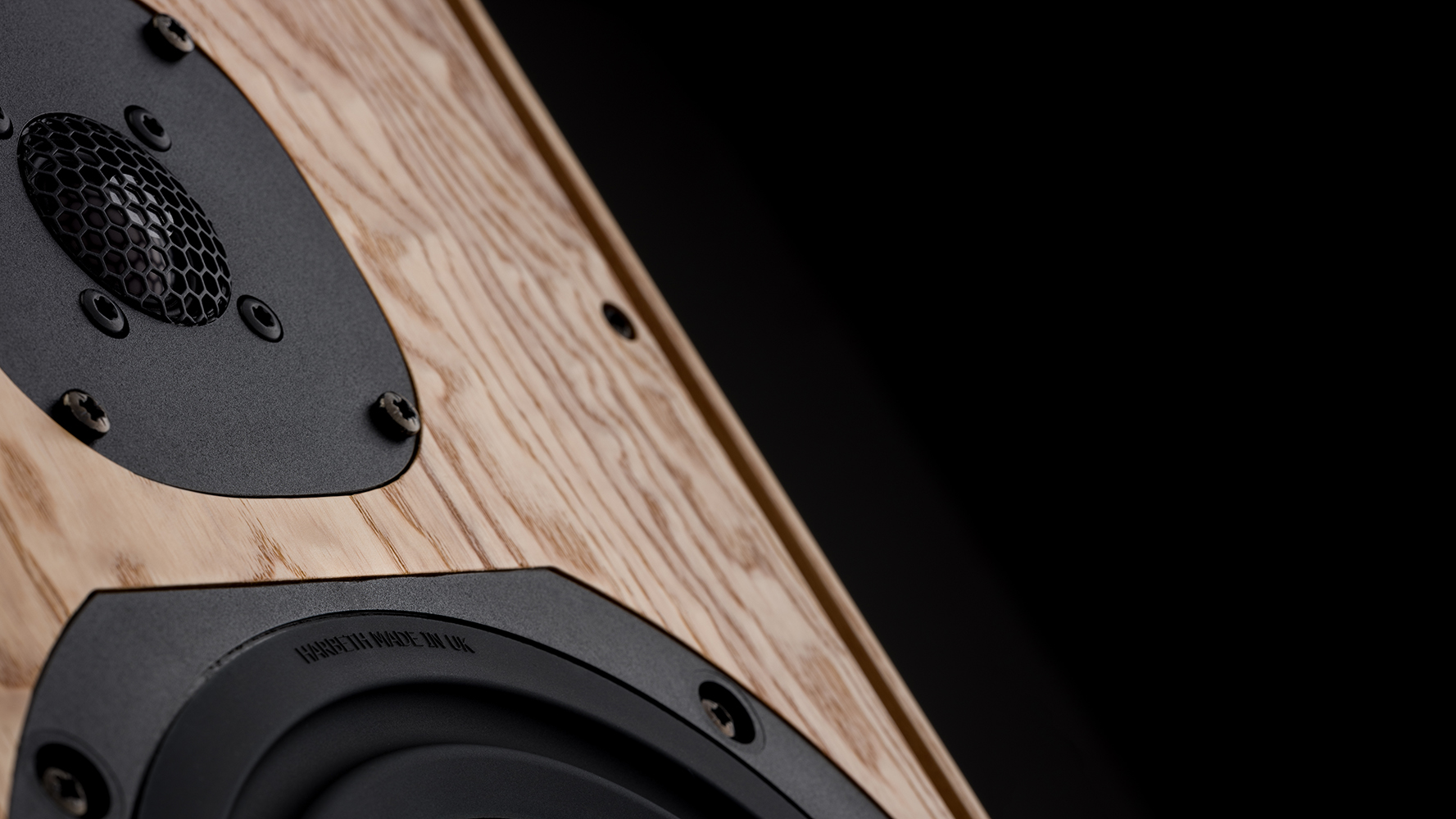
Fairly unusually, the cone’s dust-cap is made from exactly the same material as the cone. The driver is so well-made that initially it appears as though the cone and dust-cap are a single moulding, but in fact the dust-cap is attached separately. In fact it’s the very last item to be added, which is one reason the join is nigh-on invisible.
As for the surround suspension, it’s made from rubber, which is excellent news for Australians, because the extremely high levels of ultraviolet (UV) radiation in Australia mean that roll surrounds made from foam usually start to fall apart after about five years, whereas rubber roll surrounds are virtually indestructible.
The surround is also unusual, being a ‘reverse’ roll that dips inwards, rather than bulging outwards. There are many advantages to this design, but in the case of the 7ES-3 XD one of them is that the grille cloth can be fitted tightly over the front baffle without affecting cone movement. The tweeter on the 7ES-3 XD is ferrofluid-cooled with a 25mm dome that’s protected by a black metal mesh.
As you can see from the photographs of these Harbeth speakers, they’re front-ported, using a single conventional tubular port that’s 70mm long and 50mm in diameter. There is no radiusing at either end of the port, but the business end has a ‘half-arrowhead’ profile, so it sits a little proud of the baffle, with the external surface running at an angle down to the baffle.
This makes for a very ‘neat’ visual appearance.Harbeth speakers don’t weigh much because the company prefers to control panel resonances with tuning devices (damping mats, mostly) rather than by increasing the mass of the panels, so whereas most loudspeaker manufacturers use 19mm material, all the panels on the 7ES-3 XD except for the front baffle are only 12mm thick… and even the baffle of the 7ES-3 XD is only 18mm-thick stock.
As for the wood Harbeth uses for its cabinets, it’s high-density fibre-board that is veneered on both sides. This ‘dual-side’ veneering technique is a much better than using just a single veneer on the outer wall (the technique used by most speaker manufacturers) as it seals the board better against climatic conditions and ensures dimensional stability.
Unlike most modern loudspeaker cabinets, which are constructed without any visible seams, joints or fixings, the Harbeth 7ES-3 XD cabinets have clearly visible joints and fixings, in particular the 12 screws that hold the rear panel to the two side panels and to the top and bottom panels.
The heads of these screws holding the 30.2 together are ‘tamper-proof’ Pozidrive PS2 types, so you’d need a special screwdriver to remove them (something that I strongly recommend you not do!). The screws on the rear are stainless steel, which I think look great. The screws on the baffle are black steel so that when the grille is on you can’t see them at all.
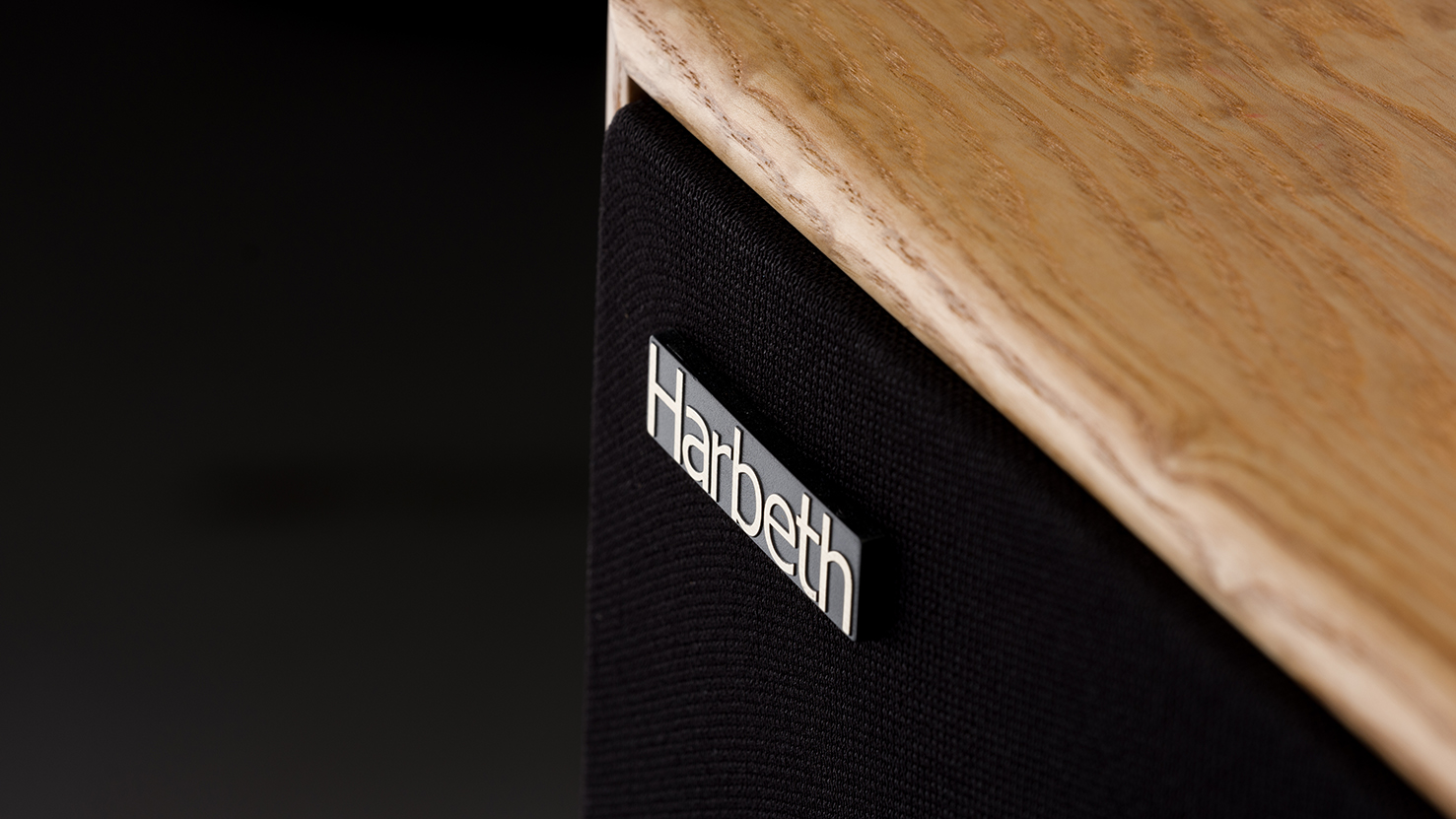
As for those grilles, Harbeth’s grilles are, to the best of my knowledge, unique. Instead of being made from the usual wood or plastic and attaching to the front panel using plastic pegs, the frame of the grille on the Compact 7ES-3 XD is made from flat mild steel, which press-fits into a rather deep and very narrow groove that runs around the periphery of the front baffle.
This technique means you won’t get any unwanted reflections from the grille frame when you are using the speakers with the grille in place (those reflections being one of the reasons many audiophiles remove loudspeaker grilles for their serious listening sessions).
In my previous Harbeth reviews, I have nearly always mentioned how difficult it is to remove these grilles, indeed on one occasion I had to point out that a previous reviewer had damaged the cabinet of my review sample by using a sharp tool of some kind – probably a flat-bladed screwdriver – to pry the grille off.
Why would you want to remove the grilles? As I said earlier, some audiophiles think speakers sound better without grilles. Others just like to see the drivers of their speakers, even if there’s no difference in sound quality. And if you don’t fit into either of these categories, you will sometimes have to remove the grilles to remove dust so that they maintain their ‘black’ appearance.
I once suggested you could vacuum speaker grilles whilst they were on the speakers… though I did point out you’d need to do this very carefully! Given the power of modern vacuum cleaners, I don’t think I’d recommend this now.
One thing I had never thought to do is actually ask Harbeth how to remove the grilles. And to tell the truth, it wouldn’t have occurred to me to ask. In fact it was this magazine’s editor who asked, because he wanted to photograph the speakers without their grilles. It turns out there’s a trick to it, and the trick is to get a neodymium magnet – two would probably be better – and use these to remove the grilles. Easy! (You are able to buy neodymium magnets from any Jaycar store.)
If you want to remove the frames regularly, you should buy four or more neodymium magnets and glue them into the corners of a board that’s the same size as the front baffle. Then to remove the grille, you’d simply put the board up against the grille, at which point the magnets would interact with the steel frame so that when you pull away the board, the grille will come with it.
Do you remember that I said earlier that different finishes were available depending on model? Well the Harbeth Compact 7ES-3 XD is available only in Cherry or Tamo Ash. Each cabinet measures 520 x 272 x 305mm (HWD) but if depth is critical for you, you’ll have to add 12mm to that to account for the length of the binding posts on the rear panel.

The Harbeth-branded binding posts (I believe they’re made for Harbeth by German connector specialist WBT) are, incidentally, a truly excellent design, being multi-way with a collar included to make it really easy to get a ‘bite’ onto bare wire, if this is your preferred method of speaker connection.
You may need help connecting them if you’re colour-blind though, because although the terminals are colour-coded (red and black) there are no ‘+’ or ‘–’ symbols. This is not an oversight, it’s because unlike most terminals, which are fitted on metal or plastic plates, those on the Compact 7ES-3 XD go directly through the wood of the rear panel and locate directly on the x/o PCB.
Harbeth history
Harbeth was founded in 1977 by ex-BBC engineer Hugh Dudley Harwood who created the name by joining the first three letters of his surname to the last four letters of his wife Elizabeth’s Christian name. He founded the company to commercialise the use of polypropylene as a material to form speaker cones.
Harwood worked in the British Broadcasting Corporation’s Research Department (Engineering Division) for nearly twenty years and was instrumental in the design and development of many loudspeakers for the BBC, including the famous LS3/5 and LS 3/5A broadcast monitors, the manufacture of which the BBC subsequently licensed to various famous British speaker manufacturers, including KEF, Rogers and Chartwell. Although Harwood always gets the credit for the design, he was aided by BBC designers Michael Whatton and Reg Mills, as well as Gordon Monteath, who was Head of the Research Department at the time.
They designed the LS3/5 because the BBC required an accurate, low-distortion loudspeaker with good dynamic range in order that its studio operators could use them in tightly confined spaces to monitor broadcasts and, at that time, despite a well-documented search that evaluated dozens of contenders from right around the world, it could find no commercially-produced small loudspeaker that met its stringent requirements for naturalness and sonic neutrality.
Harwood and his team first came up with the LS3/5, then the LS3/5A, and followed up with the lesser-known LS 3/7 and LS 5/8 models. It was while developing these that Harwood became dissatisfied with the Bextrene copolymer being used to manufacture the cones for these speakers. One issue was that it was difficult to maintain consistency from batch to batch, so they ended up throwing many cones away.
Another issue was that raw Bextrene tended to have a ‘quacking’ sound at certain frequencies, and so all the cones, once formed, had to then be damped by applying a coating, which was known as ‘doping the cone’. Because this doping was done by hand, it was not only labour-intensive, but also meant that every cone was slightly different, because the coating could not be applied consistently.
It was because of all these issues that Harwood was instrumental in pioneering the use of polypropylene copolymer cones at the BBC, and while he was there, patented – in his own name – the use of polypropylene as a cone material (UK Patent 1563511). In order to commercialise his patent, Harwood left the BBC and established Harbeth. His first speaker (originally called the ‘HL Monitor’, but now retrospectively identified as the ‘HL1’ – was the first loudspeaker in the world to use a polypropylene cone.
Harwood used polypropylene cones for more than a decade until he switched to using the then-new TPX material, first in the HL Monitor Mk4, and later the original Compact (which was designed by Alan Shaw).
Although TPX was superior to polypropylene as a cone material, it was difficult to source, and it was because of this difficulty that Harwood and Shaw applied for and won a British Government Science & Engineering Research Council research grant that allowed them to thoroughly examine alternative material solutions and then invent, patent and trademark their own plastic formulation: RADIAL [Research and Development In Advanced Loudspeakers].
Harbeth is now solely owned by Alan A. Shaw, who is also its sole speaker designer.
He says that all his designs are still based on the BBC’s loudspeaker legacy and on progressive improvements, one of which was the development of the improved RADIAL2 cone material.
Listening
Harbeth is very helpful about telling you where you should position its 7ES-3 XD loudspeakers in order to extract the best performance from them, saying that they should be 30cm or more from a rear wall and placed on stands that bring the ears level with the tweeters. It also helpfully notes that the tweeters are ‘440mm up from the cabinet base’ which should help you when shopping for stands, as Harbeth doesn’t make stands for its speakers.
I can only assume this is also part of the BBC heritage, where the speakers were in most cases placed on wall-mounted brackets. (Note that they were not actually attached to the wall or to the brackets, just sat on the angled brackets themselves.) This may suit you, and because of the front-firing bass reflex port, it’s certainly an option… but you may prefer to use stands.
Whatever method you use to support these speakers, you should be aware that you should not ‘anchor’ the cabinet to the stand by using Blu-tac or a similar substance. Although you’ll always find the sound of Harbeth speakers ‘dynamic’ (about which more later on) you’ll find their sound is more dynamic and expansive when that light-weight cabinet is free to do its thing.
I would imagine that ‘best’ performance would come about if the cabinet was suspended in mid-air but as this is obviously impossible, the next best solution is to minimise the areas where the cabinet touches whatever is supporting it. Some experimentation with support devices might be profitable.
I could not find any information about this topic on Harbeth’s website, but since that site also serves as the home for the very active Harbeth User Group (which goes by the friendly acronym ‘HUG’), I am sure the members of that group would be more than happy to tell you what works and what doesn’t. Obviously, you should also consult your Harbeth purveyor, who I am certain would be more than happy to sell you a pair of suitable stands.
Obviously the tweeters need to be at ear level, but I also found that I far preferred the sound when both the left and right speakers were toed-in so the sound-paths converged exactly at my listening (head) position, because I found that – in my room at least – this configuration not only delivered the best stereo imaging but also the best high-frequency response.
I think it was J. Gordon Holt, the founder of Stereophile, who said something along the lines of ‘if you don’t get the midrange right, nothing else matters’ and never a truer comment was made. Basically, this is because all human speech lies within a very narrow range, in general the fundamental frequencies are at around 100–120Hz for men and around 200–240Hz for women, but in order to understand speech, it’s essential to be able to distinguish consonants (k, p, s, t, etc.) and these are found above 500Hz and more specifically around 2–4kHz.
This means the human ear and the brain that analyses the sounds detected by that ear are superbly tuned for the vocal range and can hear even the tiniest errors and discrepancies at these frequencies... errors that, quite frankly, it cannot detect at all at lower and higher frequencies.
The two instruments loudspeakers find most difficult to reproduce are the human voice and the piano. The voice is most difficult because the ear can detect even the smallest changes in timbre and pitch, and the piano because, well, it’s a percussive stringed instrument, so it seemed appropriate that I should start my auditions with recordings that involved both the human voice and the piano.
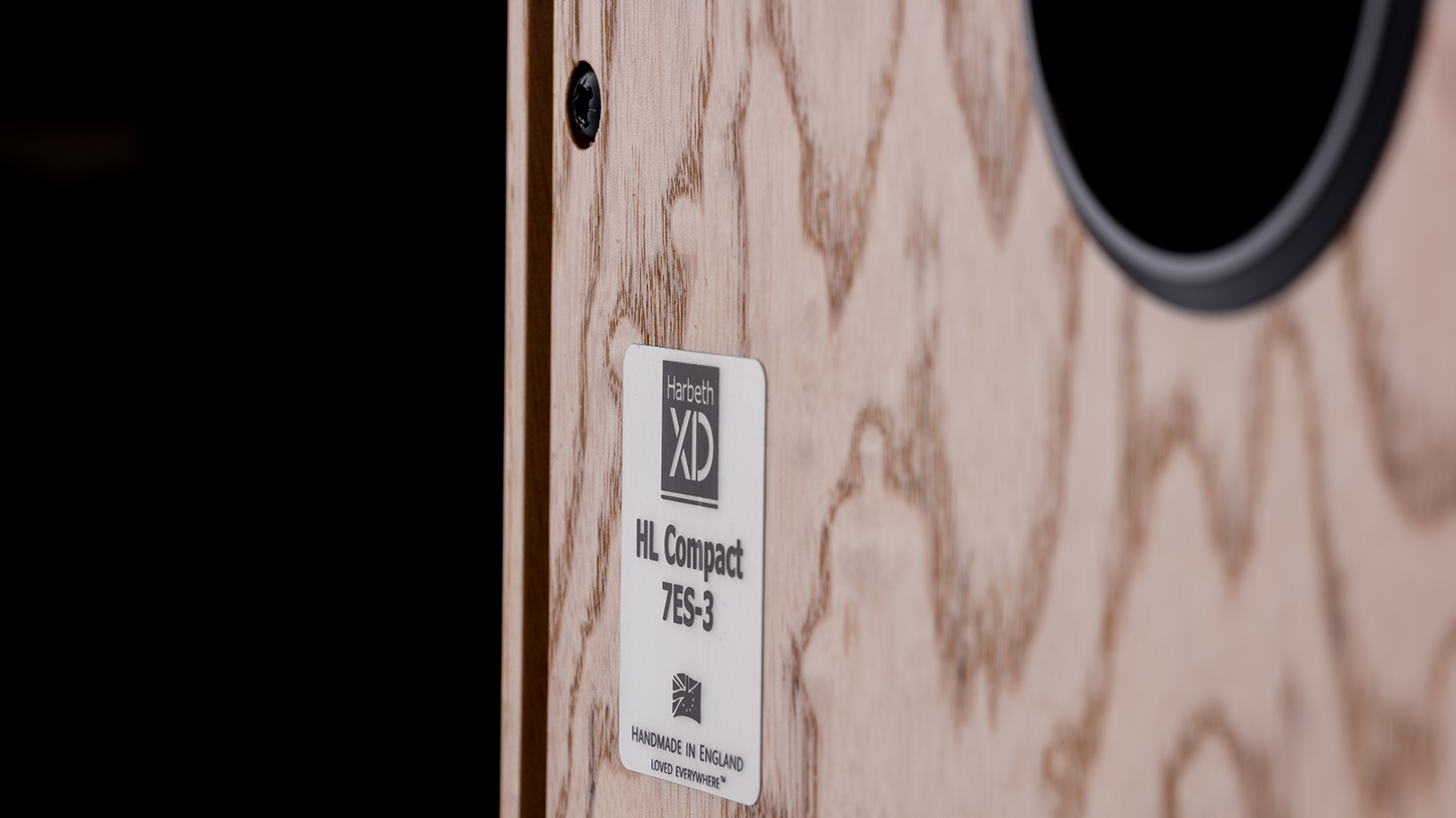
Alicia Keys seemed a good place to start, so I fired up VH1 Storytellers, recorded live at New York’s Metropolis Studios. It’s a great album with great sound that’s not overproduced, though I think I would have balanced the volume of the piano against her voice a little better, as it’s mostly a little too forward in the mix. But what piano sound it is, and the Harbeth Compact 7ES-3 XDs delivered it fabulously well. It also delivered her unique voice fabulously well.
You can hear every crack in her delivery, every strain as she reaches up into territory where she shouldn’t really take her voice. And then there’s the incredible warmth of her spoken voice! The sounds made by the small audience are also reproduced with uncanny realism.
From there it was on to one of my favourite albums, Mary Ann Meets the Gravediggers and Other Short Stories by Regina Spektor. Hard to pick a favourite track on this one. I’m in total admiration of the pianism on Lacrimosa in particular, but she’s incredible throughout. Again the piano sound is as extraordinary as Spektor’s voice: it’s no wonder she’s an official Steinway artist. Watch her live and you’ll see she has beautiful ‘hands’ too, as pianists say.
Because Spektor might be a little too out there for some readers, I’d instead suggest that you might like Sara Bareilles’ incredible album The Blessed Unrest. Track 4, You Can Have Manhattan, is one of my all-time favourite tracks of anyone. Don’t know why exactly, but it just has an eternal atmosphere to it despite the backing she included.
It would have been better with just her and her piano. If you’re familiar with the introduction to Cassiopia you may feel the 7ES-3 XD is a little light-on in the very highest frequencies (and they’re very, very high frequencies indeed!) but if you’re not, you’ll hear nothing amiss.
My investigations into voice and piano concluded, I decided to continue listening to the human voice, but switch out the piano for a violincello, because all musicians agree that the cello’s sound is very close to that of the human voice. And what better music to listen to than Chansons Madécasses (Madagascan Songs) written by Maurice Ravel to words from the poetry collection of the same name by Évariste de Parny.
Several versions of this work are available, but I rather like the one recorded by Frederica von Stade (mezzo-soprano), Doriot Anthony Dwyer (flute), Jules Eskind (cello), and Martin Katz (piano) by CBS in its famous 30th Street Studio, where Glenn Gould made most of his recordings. I purchased it shortly after its 1981 release as an LP, which was lucky, because it was not released on CD until 2016 and then only as a part of an 18-CD set (Frederica von Stade: The Complete Columbia Recital Albums).

However, in the spirit of reviewing hi-fi components with recordings my readers can actually find, I instead listened to a stunningly good recording of the same work by flautist Andrea Oliva and her Hemisphaeria Trio, which comprises Damiana Mizzi (soprano), Roberto Mansueto (cello) and Marcos Madrigal (piano).
Titled Songs of Nature and Farewell, this CD includes not only Chansons Madécasses but also other of Ravel’s works, the first recording of pieces by the British composer James Francis Brown and a first recording of Chant d’amour de la Dame à la Licorne by the late Romanian composer Liana Alexandra.
Listening to them play Chansons Madécasses (the three songs open the CD) had me immediately riveted to my seat. For starters, recorded sound (courtesy Da Vinci Classics) is unbelievably good. The acoustic setting is perfect, and the background so silent you could hear a house fly land. But it’s the aural tapestry Ravel weaves with the instruments and voice that riveted my to my seat. It’s absolutely magical.
Mizzi’s voice in not in the same league as Frederica von Stade’s (and she’s a soprano, rather than a mezzo), but her tone, timbre and pitching are outstanding. Listening to her voice as it melds with Oliva’s flute on Il Est Doux sent shivers down my spine and then, when Madrigal’s sparse piano notes start to sound... Wow! It sounds like a cliché, but I became so involved in the music and the performance that I did totally forget that I was listening to loudspeakers, it was as if I were in some magical alternate world – which was, of course, exactly what Ravel intended.
As I hope you’ve guessed from the above, the Harbeth Compact 7ES-3 XD’s delivery of the music was perfection itself. I could really ask for no more. Indeed if I were to ask for more, it would be of the musicians, because I’d love to have a recording of this work where the singer was a baritone, because I think this vocal range works better against the sound of the cello. (I am rather hoping that Steven Isserlis might take this idea on.)
I’d never heard James Francis Brown’s La Libellule, but the lowest-octave piano notes it contains demonstrated to me perfectly that the deep bass delivery of the 7ES-3 XD is exceptionally realistic, something that’s rare to find in such a relatively small loudspeaker. If you listen to this too, pay attention to the stabbed, staccato piano notes and how the Harbeths deliver the starts and finishes with such precision, and with absolutely no distortion whatsoever. Super-impressive.
For further evaluation of the 7ES-3 XD’s midrange delivery I decided to use the vocals from Hot Chip’s fabulous (if rather dated) album Made in the Dark, which contains the band’s Grammy-winning track Ready For The Floor. Taylor and Goddard’s vocals whether sung, or spoken, and either solo or duo, were reproduced as accurately as I have ever heard them reproduced, and this is an amazingly cleanly-recorded album.
The high-frequency extension was excellent, though again maybe very slightly recessed in the very highest octave, but since this resulted in a silky-smooth, non-fatiguing delivery, it was all good.
On We’re Looking for a Whole Lot of Love, from the same album, I admired not only the way the Harbeths delivered the ultra-low synth bass line, but also the claps, the tambourine shakers and, not least, the electric organ. Many speakers have difficulty delivering the extreme syncopation on this track, as well as the anti-phase sounds, but the 7ES-3 XDs delivered everything flawlessly.
I evaluated the ability of the Harbeth 7ES-3 XDs to create a stereo image with the classic Never Mind the Bullocks, Here’s the Sex Pistols. I love this whole album, but my admiration is mostly for the way Chris Thomas captured the sound of Paul Cooke’s drum kit.
His kit sounds impressive on all the tracks, but perhaps is most impressive on Pretty Vacant and the following track, New York. You’re left in absolutely no doubt that you’re listening to a full kit, and the drum and cymbal lay-out is made crystal-clear by the Harbeths, which formed a totally coherent whole-stage image. At the same time they also delivered the screaming tone of Steve Jones’s lead guitar and Johnny Rotten’s inimitable vocals, right down to the raspberry that concludes the album’s closer (EMI).
Nearly half a century later, this album’s most controversial track, God Save The Queen (banned at the time by almost every radio station in the UK) now seems almost prophetic.

Final verdict
It’s very appropriate that the Harbeth Compact 7ES-3 XD speakers are distributed in Australia by Audio Magic, because these are magic-sounding speakers indeed! The midrange is truly miraculous, the level of bass from such a small cabinet/driver combo is magical, and the way the speakers reveal the highest treble sounds without etching it is also clever.
But by far the biggest trick these speakers pull off is making you think you’re listening to the real thing. Amazing!
Detailed lab test results
Graph 1 shows the in-room frequency response of the Harbeth Compact 7ES-3 XD loudspeakers when measured using a pink noise test stimulus. It’s the averaged result of nine individual measurements, taken in a grid pattern with the tweeter at the centre of the grid. You can see that it’s extraordinarily flat – monitor-standard flat in fact – not only across the midrange, but also in the upper bass and the lower and upper treble regions.
Across the area between 2kHz and 8kHz, the response is so linear that it essentially tracks the graphing grid, so it’s essentially ±0.1dB. Between 140Hz and 2kHz, the frequency response is better than ±0.6dB! Rarely do I see such a linear response in any loudspeaker that does not have the benefit of an inbuilt amplifier that uses digital signal processing to compensate for loudspeaker irregularities.
If we take the 85dBSPL graphing line as the reference axis, you can see that the response is essentially only slightly above this axis between 350Hz and 2kHz, and at its greatest deviation, at around 1.1kHz, it’s only about 1.2dB above it.
And if we look at the region where almost all musical activity takes place (and certainly all singing), the Harbeth 7ES-3 XD’s response is 100Hz to 10kHz ±1.25dB. That’s an outstandingly good result, as you don’t need me to tell you.
As you’d expect, given the size of the single bass/midrange driver and the size of the cabinet, the low frequencies roll off below 100Hz, but they do so only gradually and do so very smoothly. You can see where the output of the port kicks in to reinforce and extend the bass, so we really don’t see a steep roll-off until 45Hz.
The in-room response of Graph 1 shows the response that will be delivered in a room as perceived by the human ear, but Graph 2 shows the high-frequency response in high detail, and with extended high-frequency capture. This is the frequency response the Harbeth Compact 7SE-3 XD would deliver in an anechoic chamber.
You can see that despite the increased resolution, the response is still spectacularly flat out to 4kHz, with no perturbations or significant deviations from reference. Above 4kHz, the response is quite different depending on whether you decide to leave the grille in place (red trace) or remove it (black trace).
With the grille in place the response is smoother out to 8.5kHz than with the grille off, but above 8.5kHz it rolls off a little more quickly than without the grille and is somewhat lower in level overall out to 16kHz, where the output becomes identical, no matter whether the grille is on or off. Personally, I’d prefer the increased linearity below 8.5kHz, so I would recommend leaving the grilles on.
You can see that the tweeter is 6dB down at 20kHz referenced to the midrange driver’s level at 600Hz. Above 20kHz the tweeter exhibits a fairly strong resonant peak at 27kHz of the type I’d expect to see in a hard-dome tweeter. The smaller resonant peak at 32kHz could be due to the perforated metal cover protecting the tweeter, or related to the dome in some way. Either way, both these peaks are comfortably above the range of human hearing.
Newport Test Labs measures low-frequency extension using a near-field test method, the result of which is shown in Graph 3. You can see from the output of the bass/midrange driver (black trace) that the cabinet is tuned for 35Hz, but that the port delivers its maximum output at just a little below this frequency.
This would suggest to me that designer Alan A. Shaw is doing his best to extract maximum bass output from it. The port’s output is very well-behaved: there’s a nice smooth roll-off either side of its peak output and there is no leakage of higher frequencies from it at all. Very nice!
The ‘wobbles’ in the impedance trace shown in Graph 4 as measured by Newport Test Labs of the Harbeth Compact 7ES-3 XD between around 120Hz and 300Hz are most likely due to cabinet resonances, but are quite minor. The impedance itself remains completely above 6Ω except for a very small region between 2.4kHz and 3.3kHz where it drops to 5.6Ω.
This relatively high impedance, combined with the benign phase response (blue trace) means this Harbeth design will be a very easy load for any amplifier. It also means the design is nominally a 6Ω one, exactly as claimed by Harbeth.
However, the amplifier you use should have a rather higher output than you might expect, because in delivering such a linear response, it appears that Shaw has sacrificed a little efficiency, with Newport Test Labs reporting that using its standard stringent test methodology, the Harbeth Compact 7ES-3 XD delivered an output of 86dBSPL at one metre for a 2.83Veq input level.
This result exactly reflects Harbeth’s specification for this parameter. But when I say ‘higher output’ I mean only that you’ll extract best performance if your amplifier is rated at more than 60-watts per channel.
Achieving an overall frequency response of 45Hz to 23kHz ±3.7dB, along with a very respectable sensitivity of 86dBSPL and a very easy-to-drive impedance is no mean feat for a speaker designer, and I can only say that Shaw has done an outstandingly good job.
Australian Hi-Fi is one of What Hi-Fi?’s sister titles from Down Under and Australia’s longest-running and most successful hi-fi magazines, having been in continuous publication since 1969. Now edited by What Hi-Fi?'s Becky Roberts, every issue is packed with authoritative reviews of hi-fi equipment ranging from portables to state-of-the-art audiophile systems (and everything in between), information on new product launches, and ‘how-to’ articles to help you get the best quality sound for your home.
Click here for more information about Australian Hi-Fi, including links to buy individual digital editions and details on how best to subscribe.

